Saudi-Japan collaboration furthers Red Sea research
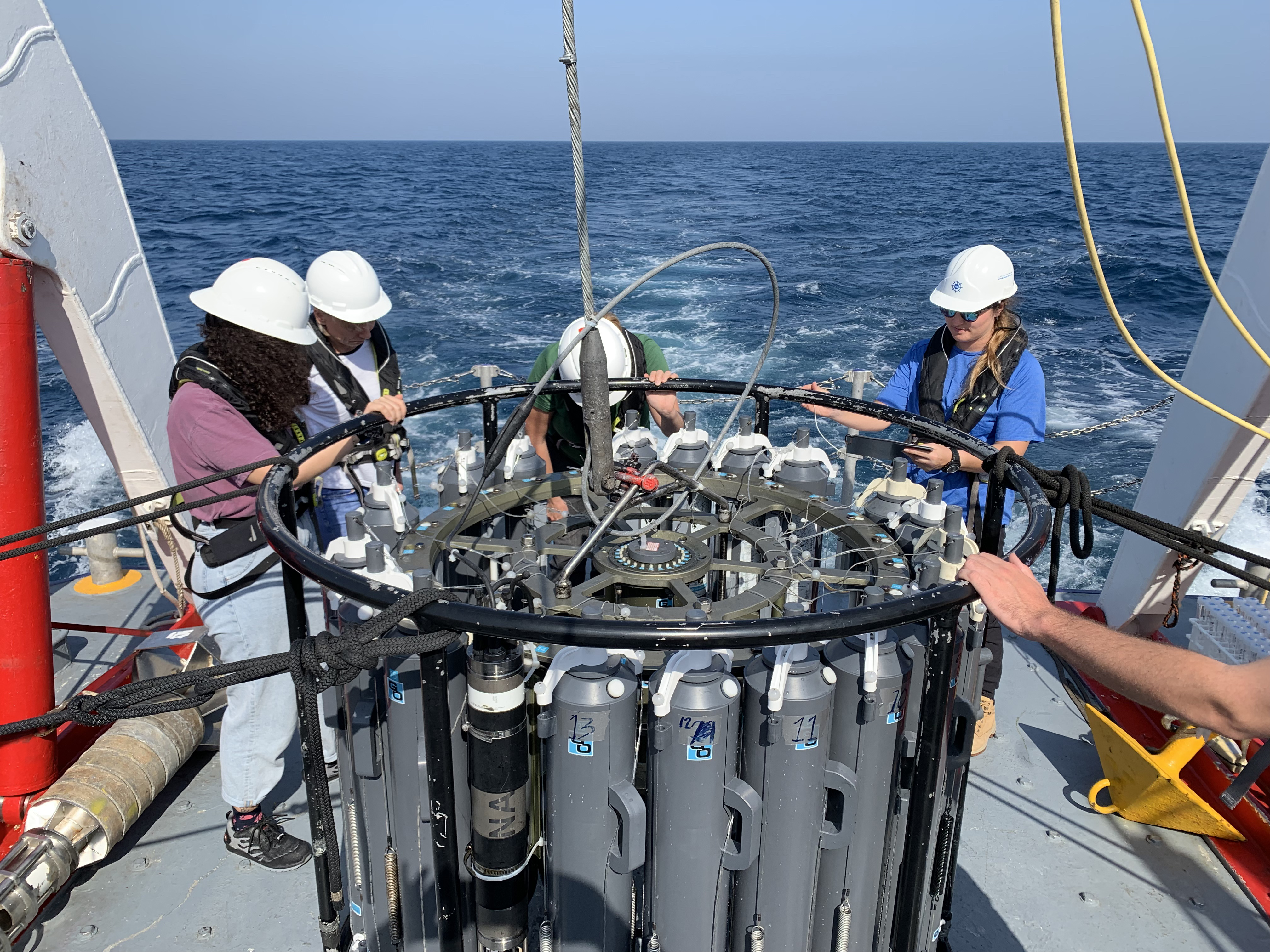
KAUST-JAMSTEC crew prepare to submerge a 24-point Rosette Water Sampling system into the Red Sea at Al-Wajh Reef to sample water and measure temperature-salinity. Photo: KAUST
New technologies and expertise are being applied to study areas of the Red Sea, thanks to a partnership between Saudi Arabia and Japan. Researchers at the King Abdullah University of Science and Technology (KAUST) have teamed with engineers and scientists at the Japan Agency for Marine-Earth Science and Technology (JAMSTEC), a leading institute in deep marine science, to research shallow reef and deep-water environments using Japanese specialty equipment and the KAUST-owned research vessel, RV Thuwal.
The first KAUST-JAMSTEC pilot projects are made possible with funds from the Japanese Ministry of Economy, Trade and Industry (METI) and the KAUST Office of the Vice President for Research. International projects such as this are not only fostering cultural and international relations, but also science initiatives, giving researchers impetus to investigate and explore places such as the Red Sea, which still has many areas to be discovered and better understood.
KAUST Vice President for Research, Distinguished Professor Donal Bradley said that the collaboration provides a cross-disciplinary, multi-divisional platform for sharing resources and expertise.
“JAMSTEC has a long history of pioneering deep-water research and development of exploration infrastructure, with a modern vessel fleet and hi-tech marine equipment that will be of enormous benefit to our research goals,” said Bradley. “KAUST provides local logistical and technical support through our Coastal and Marine Resources Core Lab (CMR), and, importantly, a deep knowledge of many aspects of the Red Sea, from geoscience to ecology.”
Sean Toczko, deputy group leader of the Institute for Marine-Earth Exploration and Engineering (MarE3) Expedition Management Group within JAMSTEC, added, “METI is pushing for more technological and bilateral research collaborations with Saudi Arabia. The partnership with KAUST is a great match, and the potential of getting interesting results or discoveries in the Red Sea is very high.”
The JAMSTEC-KAUST initiative will help address critical data gaps about the young Red Sea. Given the sea’s central role to the Kingdom’s giga projects, it will also provide helpful information for guiding government regulations and legislation for its development and protection.
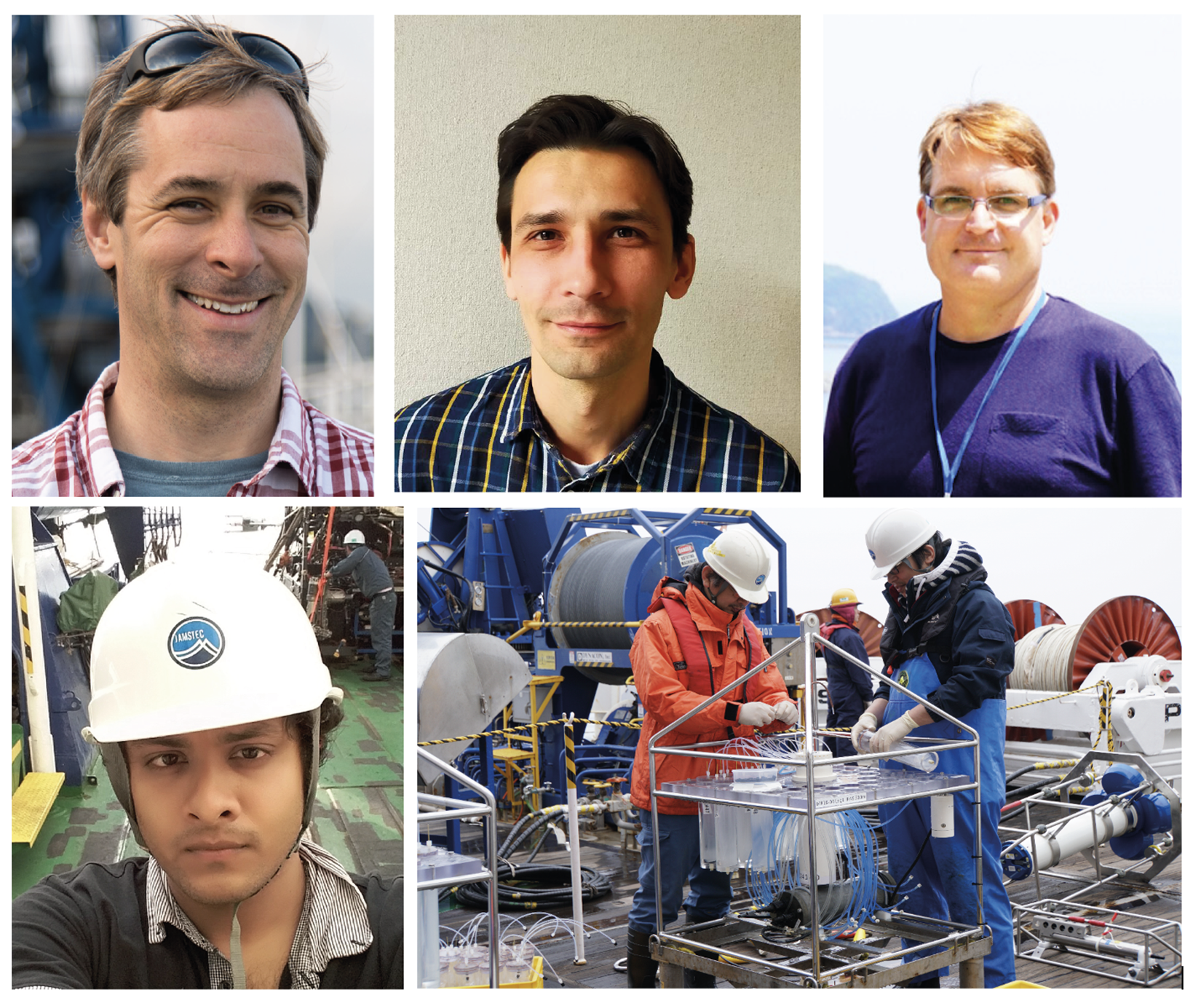
Scientific team from JAMSTEC involved in the cruise. From left to right: Dr. Sean Toczko, Adam Wspanialy (Project PIs, Expedition Management Group, MarE3), Dr. Dhugal Lindsay (gelatinous zooplankton specialist), Dr. Mehul Naresh Sangekar (underwater robotics, seafloor observation specialist), Dr. Hiroshi Uchida (left, physical oceanography specialist), and Dr. Masahide Wakita (right, carbon cycle and chemical oceanography specialist). Photo courtesy JAMSTEC
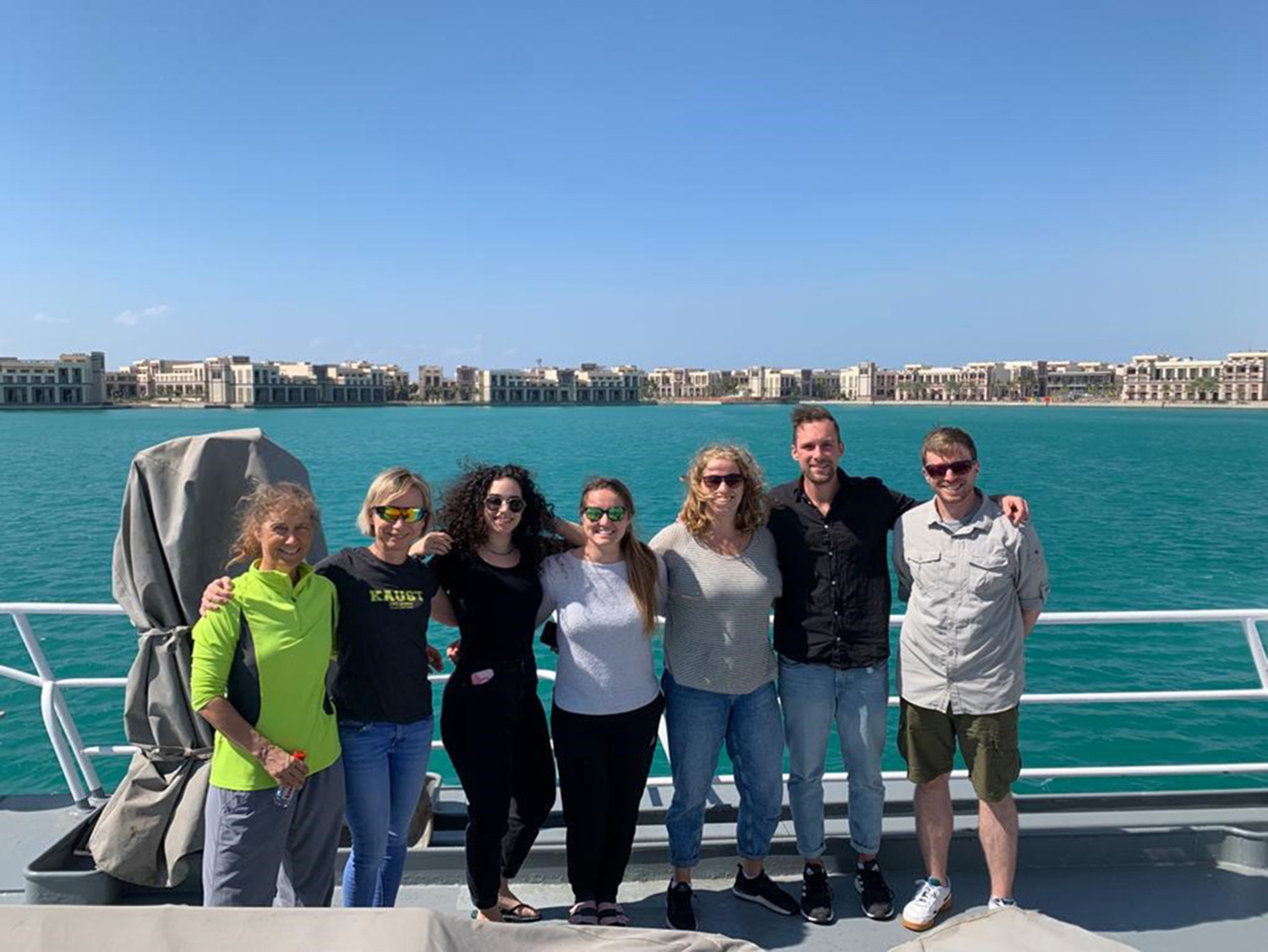
Scientific team from KAUST involved in the cruise. From left to right: Dr. Ute Langner (marine biologist), Prof. Hildegard Westphal (carbonate sedimentologist), Silvia Vimercati (coral specialist), Eloise Richardson (fish specialist), Marlena Joppien and Dominik Nommensen (carbonate sedimentologists), and Dr. Alexander Petrovic (chief scientist). Photo courtesy Ute Langner / KAUST
Research reconnaissance
Under the lead and dedicated efforts of chief scientist Alexander Petrovic, KAUST, a multidisciplinary team of KAUST-JAMSTEC scientists completed their first research cruise in February 2022 to the Al-Wajh platform, a reef complex located in the mesophotic (“middle light”) layer of the Red Sea (i.e., the upper 200 m below sea level). Situated on top of a thick, creeping salt substrate, the reefs are deforming, moving and partially drowning as the salt creeps into deeper waters.
The science team investigated one of these submerged coral reef complexes from a sedimentological, biological and oceanographic perspective. In its vicinity, the platform features active volcano vents, hot submarine springs, metal-rich brine pools, and a world of biological organisms uniquely evolved to survive here.
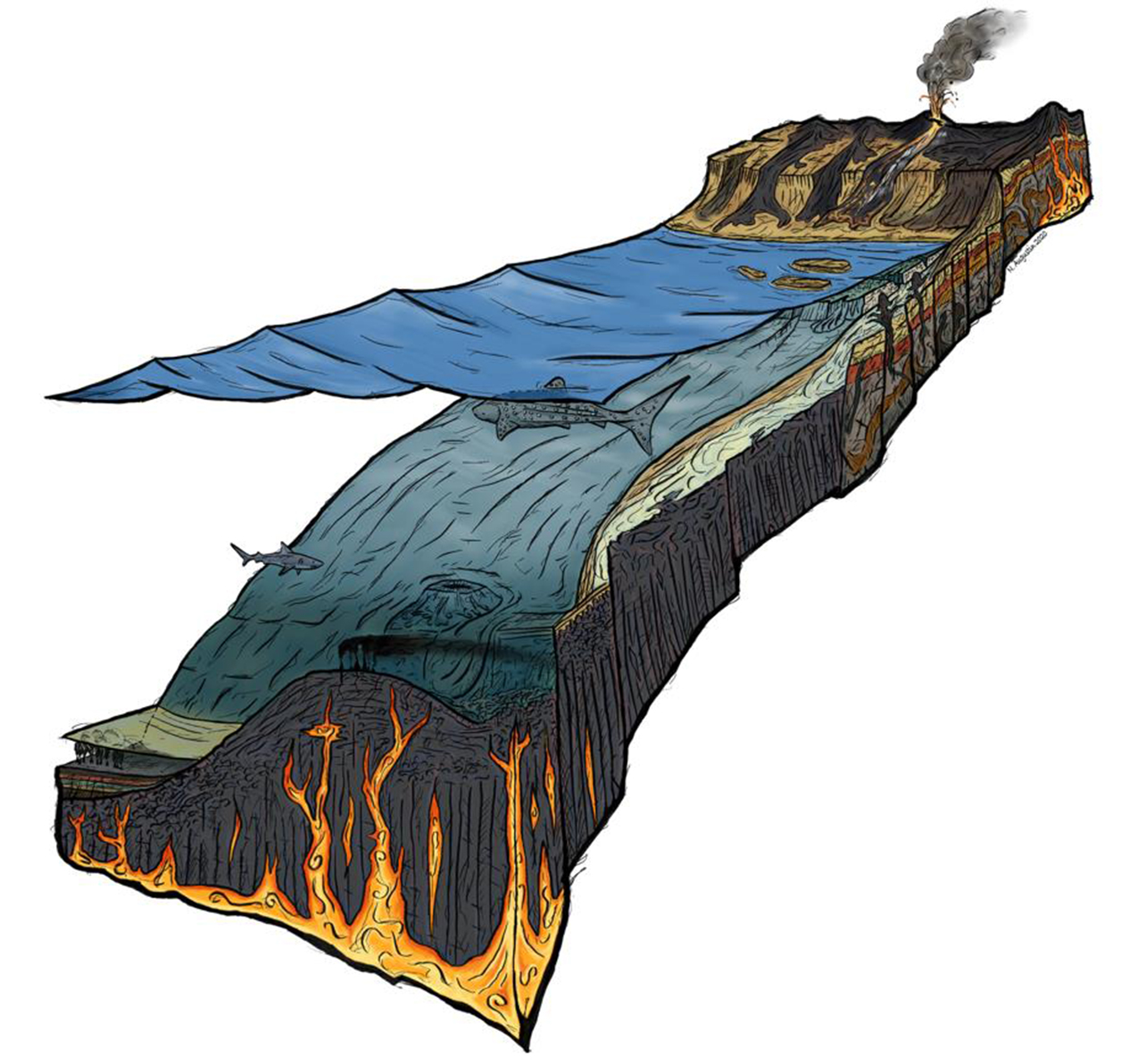
Illustration of the underwater topography of the Red Sea showing thermal vents, brine pools and other features. Illustration courtesy Froukje van der Zwan & Nico Augustin
Temperatures in the Red Sea’s deep brine pools can exceed 70°C in some places — the threshold for most industrial scientific medical-grade electronics to function. Whereas KAUST instruments might corrode, melt or float in such extreme conditions, the Japanese equipment is designed to withstand high saline, temperature and pressure environments. Furthermore, they perform in depths of 3000 meters and more — essential attributes that provide opportunities to perform integrated geo- and bio-science studies. Specialty equipment includes remotely operated vehicles (ROVs), unmanned underwater vehicles (AUVs), and human operated vehicles.
JAMSTEC engineers trained KAUST scientists on the equipment and how to take measurements for various parameters, which were then used to collect samples of sediment, water, plankton and other material for shared analysis of properties such as biogeochemical and mineral composition, DNA sequences and absolute salinity. JAMSTEC high-definition video cameras, lowered into the water with a long cable attached to an ROV, recorded a range of marine life and natural phenomena.
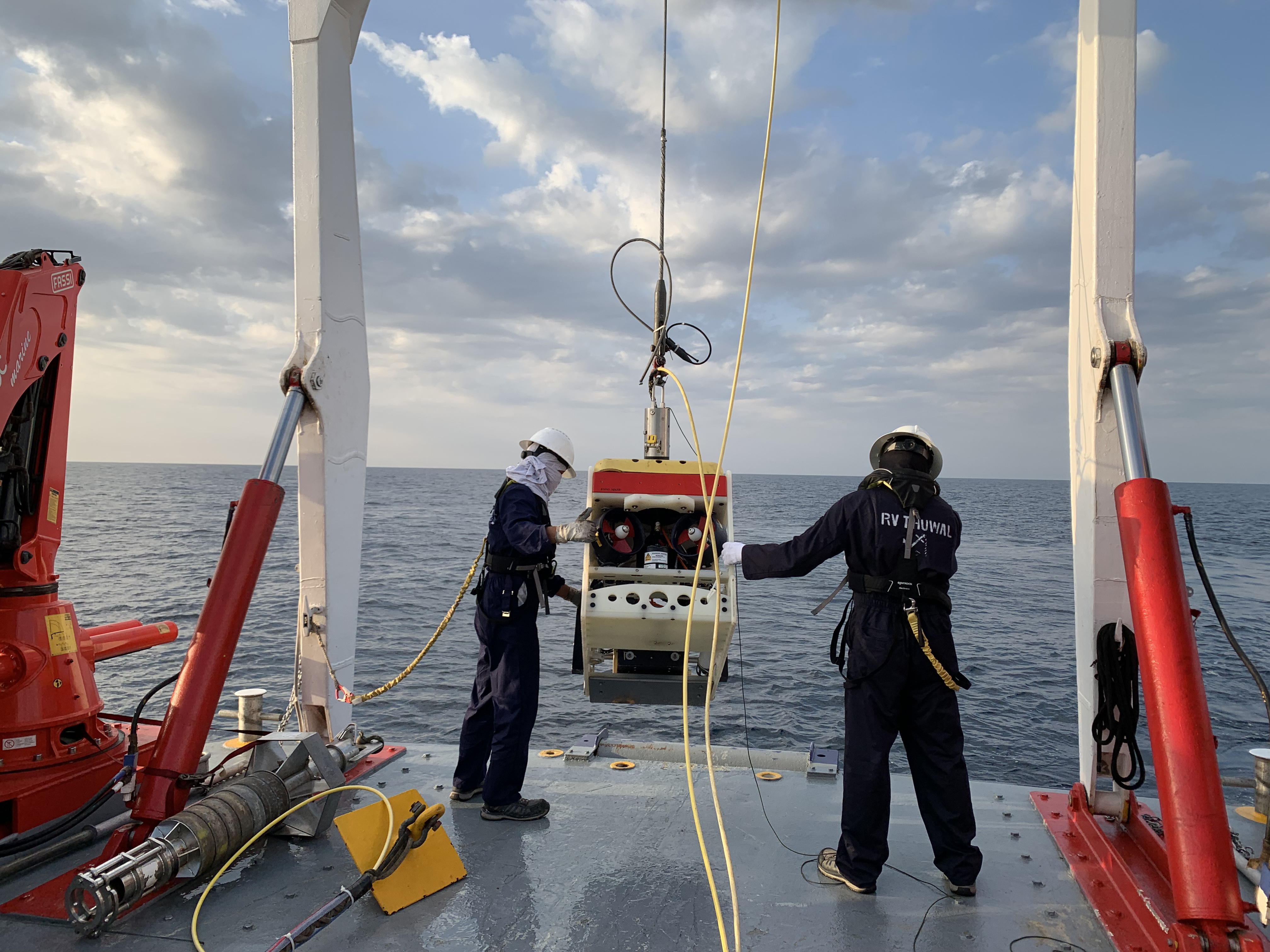
KAUST-JAMSTEC crew prepare to lower an underwater electric robotic system (ROV) into the Red Sea to monitor hard to access areas at Al-Wajh Reef. Photo: KAUST
The RV Thuwal and CMR crew are ideally suited for supporting coastal missions in the Red Sea; the staff are experienced engineers, skilled in the integration and deployment of new equipment with advanced and state of the art technologies from the ship.
Lloyd Smith, director of the KAUST Coastal and Marine Resources Core Lab (CMR), said, “While KAUST has extensive experience in the unique Red Sea environment, this partnership lets us support scientific missions that we normally wouldn’t be equipped to handle due to critical considerations. Given that CMR is a small organization, it isn’t efficient for KAUST to maintain large complex sampling systems such as those that are routinely available with JAMSTEC.”
Smith said that temperature and buoyancy are among the critical considerations. “The RV Thuwal has limited capability in waters deeper than 1000 meters. We can put KAUST samplers in the brine pools for at most, 10 minutes. If we don’t pay close attention to the metal properties of our equipment, then it will either come up very shiny, deformed or dissolved. Our AUVs (autonomous underwater vehicles) bounce off and can’t get in.”
He added that KAUST-JAMSTEC scientists and engineers see an opportunity to develop a new generation instruments designed specifically for use in the Red Sea’s hostile environments, and that a collaboration could produce tools that would be very valuable for both Japan and Saudi Arabia.
“CMR is already positioned for this task. Our crew brings a technical perspective based on working in the Red Sea for 13 years, and our facility has a pressure and temperature testing lab for conducting tech development simulations and verifications,” he said. “We know the constraints and bring the operational expertise, and JAMSTEC knows how to make the tools that can survive in extreme marine environments.”
Data analyses
With the first cruise completed, scientists from both teams are in the early stages of analyzing data collected, which will provide a baseline of research to build upon.
Hildegard Westphal, a visiting professor at KAUST with expertise in carbonate sedimentology, said the cruise was a success from a scientific point of view: “The Al-Wajh reef, which is in the process of sinking, or drowning, due to the tectonic setting, supports flourishing photic and photosymbiotic organisms adapted to live in low-light, warm water conditions, for example, certain red algae and foraminifers. We know very little about the stages a coral reef goes through when it drowns, or the mesophotic life that live here. The combination of sedimentological and biological data and video footage gathered provides unprecedented insight into the marine life and habitat unique to the Red Sea.”
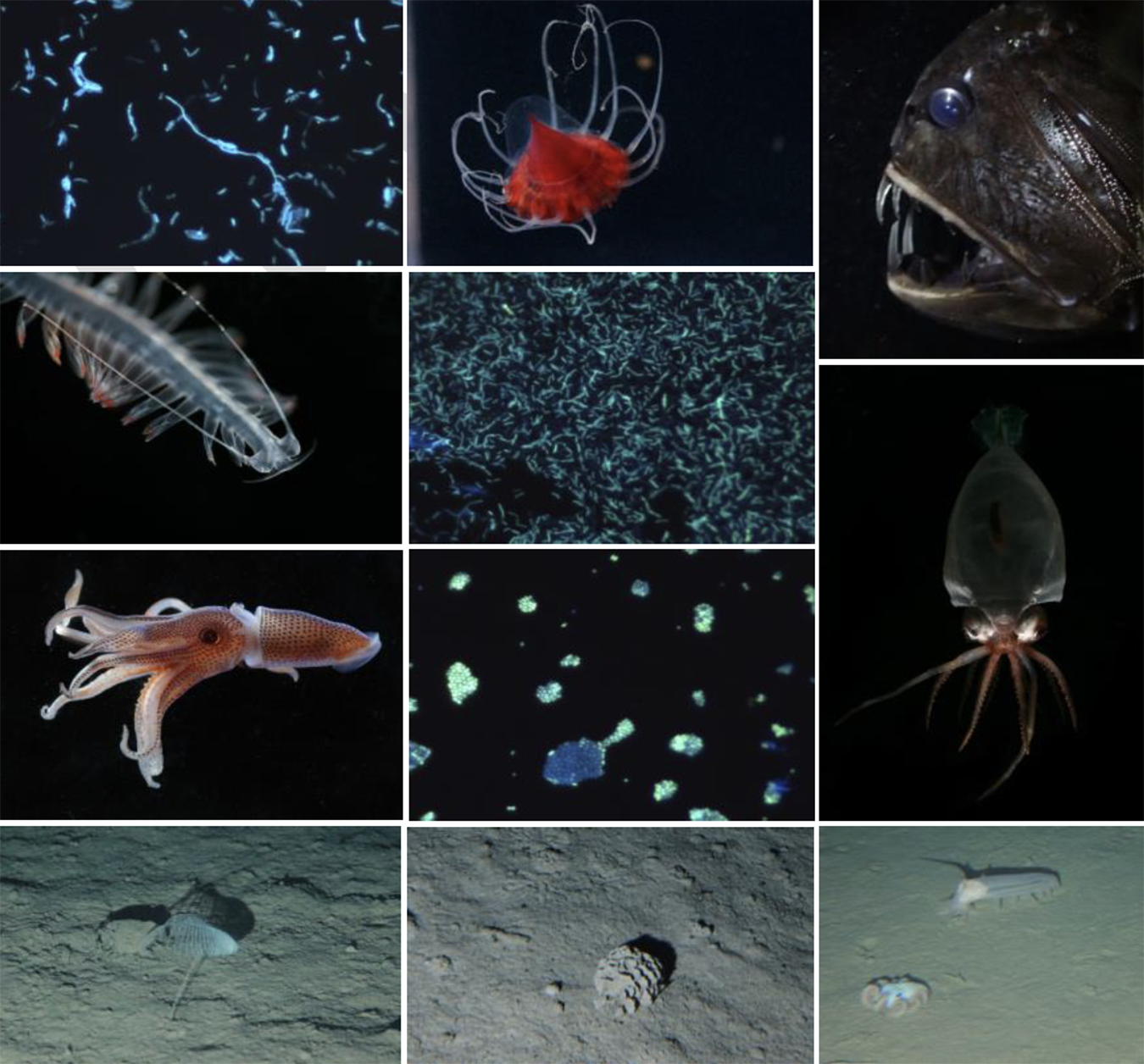
The Al-Wajh reef in the Red Sea supports a range of marine life, including flourishing photic and photosymbiotic organisms adapted to live in low-light, warm water conditions. Photo: Dhugal Lindsay / JAMSTEC; and the Red Sea Research Center / KAUST
Thomas Finkbeiner, KAUST research professor of energy resources and petroleum engineering, directs the KAUST components of the JAMSTEC collaboration. He said the sedimentary layer deposited on the Al-Wajh platform is interesting for its connection to the land. One of the largest wadis, or drainage channels, along the Red Sea is located here. When it rains, the wadi can flood quickly, carrying huge streams of gravel, rock and plant debris through its channels into the sea.
“Studying subsea core recovered from these sediments provides insight into paleo-climates and much more,” Finkbeiner said.
Dhugal Lindsay, JAMSTEC senior staff scientist in the Institute for Extra-cutting-edge Science and Technology Avant-garde Research (X-star), leads studies that investigate the floating and swimming planktonic ecosystem.
“The Red Sea has a combination of high temperatures and salinities that make it a good proxy for understanding how climate change may affect planktonic ecosystems,” he said. “We plan to use the plankton samples collected during the Thuwal cruise to investigate connectivity and climate change resilience in planktonic animals such as jellyfish, which are currently predicted, along with bacteria, to become one of the most successful groups of organisms as the oceans change.”
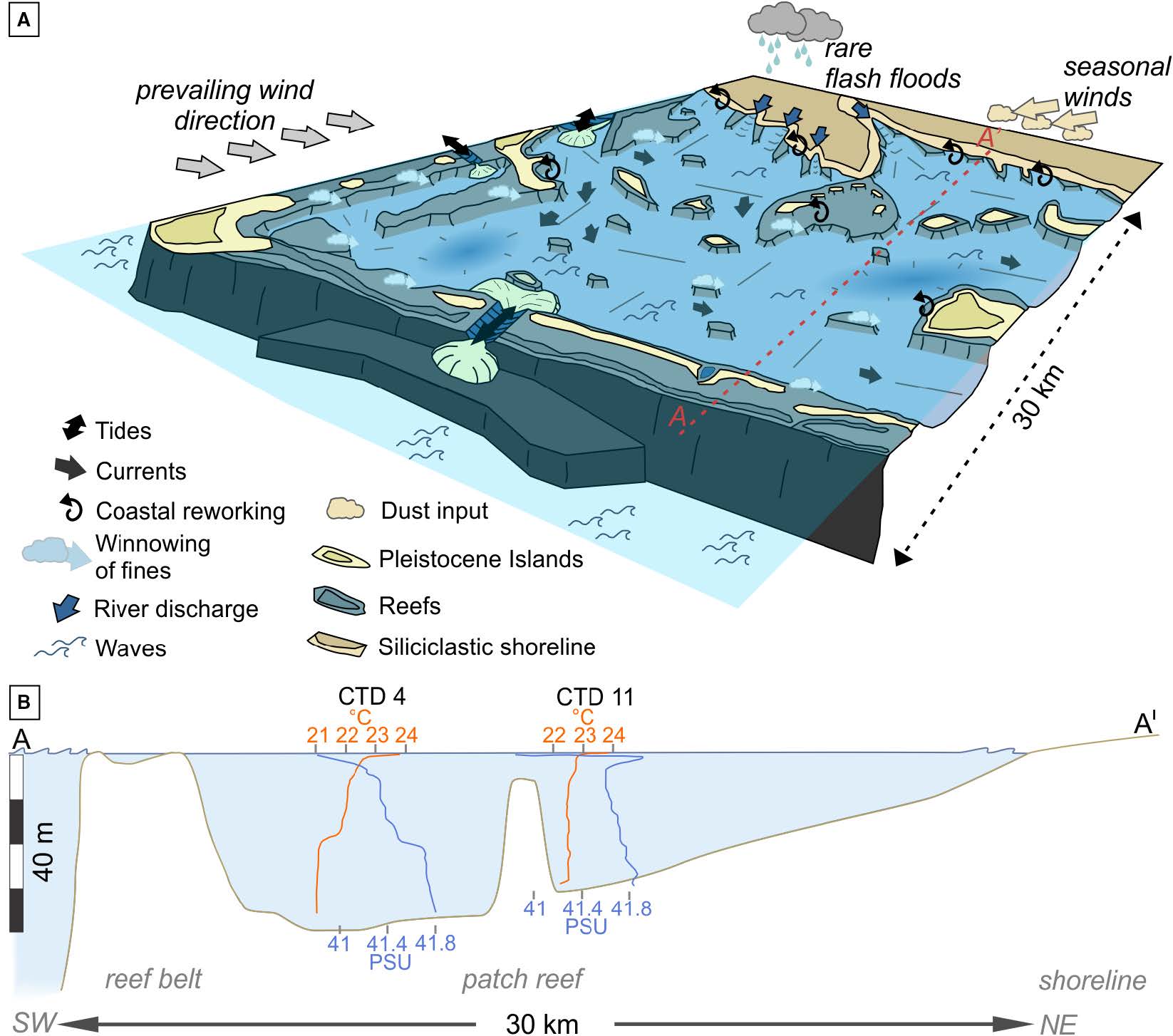
Fig. 11. (A) Schematic model of depositional processes on the Al Wajh carbonate platform. (B) Schematic southwest/ north-east dip-section illustrates the Al Wajh platform morphology from shoreline towards the reef belt. Two temperature and salinity profiles (CTD 4 and 11; Fig. 1) indicate lateral water body variations within the lagoon. Location of the dip-section is also shown in Fig. 1. Credit: Petrovic et al, Holocene sediment distribution in the Al Wajh platform lagoon (northern Red Sea, Saudi Arabia), a modern analogue for large rift basin carbonate platforms, Sedimentology 2021
Future work using ROVs would give information on the depths, temperatures, salinities and oxygen concentrations that these organisms experience to allow for more accurate modelling of the effects of climate change on oceanic ecosystems.
The core of the matter
Adam Wspanialy, a drilling engineer with the JAMSTEC/MarE3 Expedition Management team, frames the Al-Wajh project as being an important first step for future collaborations.
“This initial cruise served as a pilot for future trips. It gave information about the water column such as salinity, temperature and pressure that will help us determine what research equipment and approaches to use going forward. We also learned a great deal about how to operate and work together, which was a major objective in and of itself.”
Multiple goals guide future research projects. The Red Sea’s tectonic features and oceanic crust is one area of deep-sea research that both teams aim to investigate. The team is working with KAUST leadership as well as the Saudi Ministry of Investment (MISA) to explore bringing JAMSTEC’s Kaimei oceanographic research vessel to the Red Sea for a six-month expedition to study processes of the Red Sea floor, including its central trough.
A unique feature of Al-Wajh reef is that it is situated at the north-eastern end of a major fault zone that propagates across the Red Sea and meets the land, the result of tectonic plate movement that formed the sea 30 million years ago when the Arabian Peninsula began separating from Africa, and that continues to widen the sea by 8–16 millimeters each year.
Scientists will deploy a network of ocean bottom seismometers (OBS) on the seafloor to passively record seismic activity. The longer the equipment stays on the seafloor, the more reliable the information collected. For example, this would help scientists better understand tectonic processes between the African and Arabian plates and how these processes could potentially impact coastal areas with phenomena such as earthquakes, flooding, tsunamis and landslides — data that can be used to assess and prepare coastal communities for risks and hazards.
Deployment of JAMSTEC ocean bottom seismometers (OBS) such as this are part of a strategy to investigate underwater seismic investigations in the Red Sea. Photo: JAMSTEC
Coring is another research area of mutual interest. Drilling in the Red Sea would utilize a JAMSTEC rig with a Boring Machine System (BMS), a robot that drills automatically from the surface down to 60 meters, which is an order of magnitude longer than what the KAUST equipment can currently handle.
This won’t be the first time a core sample was collected from the Red Sea. An international team of scientists, including those from Japan, drilled a series of cores from a transect of sites in the Red Sea during the Deep Sea Drilling Project (DSDP) Expedition 23 in 1972, a time when limited marine research in the region was possible. Decades later, these cores are still very valuable for research and the insights they provide on the ongoing processes below the seafloor.
The core is currently being stored in Shikoku, Japan at the Kochi Core Center (KCC), managed by JAMSTEC as part of the International Ocean Discovery Program (IODP). JAMSTEC and KAUST are in the beginning stages of planning a trip to KCC to sample these Red Sea cores. Other parts of the core have been shipped to KAUST for non-destructive analyses.
Toczko said that bringing a Japanese vessel to the Red Sea with the advanced capability of doing research in 7 – 8000 meters deep water enables scientists to perform research at Red Sea water depths, the greatest being approximately 3000 meters, and discover what’s below the sea’s surface.
“Analyzing the previously collected core would reveal conditions about the Red Sea substrate from the deep past that we could use to better understand the early history of the Red Sea and the lands that border it,” said Toczko. “Climate change in the region and its effects on the biological evolution and development of humans and other organisms, and also geological processes involved in the evolution of the Red Sea itself, are also topics of extreme interest that future research could help clarify.”

A coral extracted from the Al-Wajh Reef of the Red Sea will be assessed for its unique properties as part of the KAUST-JAMSTEC project. Photo courtesy Ute Langner / KAUST
A living encyclopedia
With information gathered to date, and more to come, the team is building an open-source encyclopedia, or database, utilizing artificial intelligence to identify fish, corals, plankton and other living organisms. Finkbeiner said the intention is to create a multidisciplinary archive of Red Sea research that grows with time and is accessible to people, students and researchers around the world for study in areas of multidisciplinary relevance, including biology, ecology, environment, natural resources, conservation, marine technology, oceanography, geology, geochemistry, geo-hazards, paleoclimate and paleoceanography.
“We envision an encyclopedia that marine scientists can contribute to, and that the public and researchers can use to study the big mysteries of the Red Sea, such as the forces that shaped it, the origin and biodiversity of life there, newly discovered organisms and geological features, current patterns and water circulation, and potential impacts of climate change on coral reefs and the world’s future oceans, among other areas of knowledge,” he said.
In this light, he said the database will be a living library of the Red Sea with information intended to educate people for future generations.
Related Links
- Holocene sediment distribution in the Al Wajh platform lagoon (northern Red Sea, Saudi Arabia), a modern analogue for large rift basin carbonate platforms, Sedimentology 2021
- Red Sea Research Center
- The Coastal and Marine Resources Core Lab at KAUST

